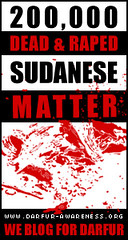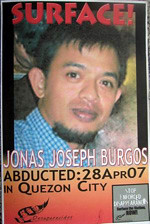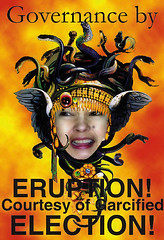Filipinos far and near pay homage to the Child Jesus
Performers dance the Sinulog in the presence of Santo Nino images at the St. Pious V Church in Buena Park, left, and at another event in San Bernardino. (Photos by Dionesio Grava and Gus Mayol) The feast of the Holy Child originates as a religious observance said to be rooted in history. In the place where it was conceived, Cebu City, the event has since radiated from being strictly an act of faith and into the temporal realm of merrymaking, cultural presentations, and Sinulog dance competitions. Among conservatives, the parade portion of the feast as now practiced in that city has drawn criticisms for its having departed from the original goal of faith and veneration towards the Santo Nino. Instead, the festive occasion has attained a circus-like atmosphere and has become a big draw for hordes of tourists and balikbayans to the homeland.
Most of these festivities are held in January and the Cebu celebration sees faith and a generous dash of commercialism collide resulting to a kind of Mardi gras that lasts for most of the waking hours and clogs the major arteries of the city. This kind of festive frenzy is also evident in other regions of the country such as in Iloilo's Dinagyang Festival and Aklan's Ati-Atihan.
In places far away from the homeland, devotees of the Santo Nino continue to do homage to their patron. Several associations dedicated to the Holy Child exist in parts where many Filipinos reside. The celebrations usually include prayer sessions (novenas), the Holy Mass, the pageantry of Sinulog, entertainment events and sumptuous feasts. It is also the practice to display images of the Holy Child in various types and sizes during these celebrations.
The Santo Niño Association of Southern California, Inc. had its annual fiesta of the Holy Child at the Ayres Hall of the L.A. Arboretum and Botanical Gardens, Arcadia. They used to hold it at the St. Cornelius Church in W. Wardlow Ave., Long Beach. The January 9 event started with the rosary and novena followed by a Holy Mass and a procession around the Ayres Hall Building. By that time it was noon and lunch was served. Soon after there was a program with outgoing president Oscar Ramirez delivering the opening remarks and incoming president Juliet Russell closing it. There was also a raffle of prizes and the usual dance, dance, dance.
Over in Buena Park, Orange County, the St. Pious V Church was filled to capacity on January 16 with Sto. Nino devotees in terno ang Barong Tagalog and finery as they attended a Holy Mass and participated in a procession. Performers in colorful costumes danced the Sinulog – a dance movement approximating the river current accompanied by the beating of drums and shouts of "Pit Senor!" That is intended to please the Child Jesus, the legend says. As usual many brought images of Him; they also brought food items for sharing during a potluck lunch. Oddly the organization has existed for 15 years without any designated or elected officers.
That same day the Batangas City Santo Nino Devotees had its 17th Annual Santo Niño Fiesta at the Santo Christopher Catholic Church located in Glendora Avenue, West Covina. As usual it was ushered in with a Holy Mass followed by a procession of Santo Nino images. Activities included the proclamation of Little Princes and coronation of Little Princesses, food, games, raffle and dancing until nighttime. This group used to hold its event at the St. Linus Catholic Church in Norwalk.
Other Santo Nino organizations that usually celebrate His feast day at this time of year include the predominantly Cebuano group in Culver City. Then there's the Glendale-based Cruzada de Santo
Niño-USA, which usually hold an Ati-Atihan-themed procession of the Holy Child in the vicinity of the Incarnation Church; the Tacloban Santo Nino devotees; the Society of Santo Nino of America; the Santo Nino group at the Our Lady of Lourdes Church located in Tujunga Canyon Boulevard in Tujunga; and that of the Philippine Independent Catholic Church based at the St. Mark's Episcopal Church in Sherman Way, City of Van Nuys.
Farther away from Los Angeles area is the yearly feast of the Holy Child at the Saint Anne Catholic Church in Union City; the one at Sacred Heart Catholic Church, Rancho Cucamonga, which is attended also by non-Filipino Catholics such as Vietnamese, Mexicans & Caucasians; the nine-day novena for the Santo Niño de Cebu at the local Catholic Church in Hayward; the Santo Nino fiesta at the St. Michael's Abbey in Lake Forest; the Santo Nino celebration by the Bullecir clan of Oxnard at the Mary Star of the Sea Church in that city; and the Sto. Nino de Cebu Association International at the St. Dominic's Catholic Church in San Francisco. And Gus and Joy Mayol, originally from Cebu, sent photos taken during a Sinulog event last January 16 hosted by a Santo Nino group in San Bernardino.
A press release from the Washington Embassy mentions that members of the Filipino community in Chesapeake, Virginia celebrated their 13th Sto. Nino and Ati-Atihan Festival last January 9. Addi Batica of Minnesota reported that their community, too, celebrated the feast of the Child Jesus. It was indoor, he said, because it's cold at this time in their place. They would have preferred to hold it in summer so that they could incorporate a fluvial parade in the nearby Mississippi River. Then we also came across an item about a statue of the Santo Nino de Cebu enshrined at Olde St. Augustine's Church in Philadelphia and a Sinulog held in Ft. Lauderdale by the Sto. Nino Sinulog Association of South Florida, Inc.
NOTE: This item also published in the Pinoy News
*********************************************************************************
 Dionesio C. Grava - Part-time community journalist based in Los Angeles and editorial writer at Forum Asia.
Dionesio C. Grava - Part-time community journalist based in Los Angeles and editorial writer at Forum Asia. 
POGB will not sell, exchange, use or allow any 3rd party access to your email for
any other purposes without exception, email exclusively for article updates only.

























0 Speak Out:
Post a Comment